Weird Western-on-Demand: The White Buffalo from MGM Limited Edition Collection
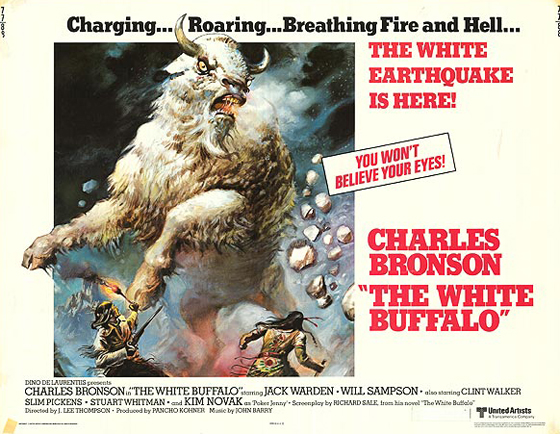 Warner Archive has so far received all the attention in my recent veer into the world of the manufacture-on-demand DVD, a dazzling universe where the big studios serve the niche movie lovers with titles that would otherwise only surface in North America on bootlegs swiped off Japanese laserdiscs. (Yeah, you own a couple of those.) Tarzan’s Greatest Adventure, The Bermuda Depths, and The Last Dinosaur all come from Warner Brothers’ MOD division. But two other studios have their own extensive MOD programs: MGM Limited Edition Collection and Universal Vault. It’s through MGM that we get the strange 1977 combo of Western and monster movie called The White Buffalo.
Warner Archive has so far received all the attention in my recent veer into the world of the manufacture-on-demand DVD, a dazzling universe where the big studios serve the niche movie lovers with titles that would otherwise only surface in North America on bootlegs swiped off Japanese laserdiscs. (Yeah, you own a couple of those.) Tarzan’s Greatest Adventure, The Bermuda Depths, and The Last Dinosaur all come from Warner Brothers’ MOD division. But two other studios have their own extensive MOD programs: MGM Limited Edition Collection and Universal Vault. It’s through MGM that we get the strange 1977 combo of Western and monster movie called The White Buffalo.
My first experience with The White Buffalo, aside from seeing ads on local television stations when it ran during “Charles Bronson Tough Guy Week,” was on an awful first-generation VHS tape I watched during college as part of an independent study of the 1970s Western. The movie was drab and a cruel disappointment considering how exciting the plot description sounded: “Wild Bill Hickok and Crazy Horse team up to hunt down a giant, possibly supernatural, white buffalo on a rampage.” How could such a crunchy high-concept result in such a bland film?
Blame “VHS goggles,” which turned the movie’s photography into mulch. The difference in The White Buffalo experience between VHS and DVD is substantial. Although the MGM Limited Edition Collection DVD is rough compared to today’s Blu-rays, it is about as good as the picture could look in standard definition without undergoing hefty restoration. The movie isn’t a lost classic, but it wins in the realm of atmosphere: eerie and bleak. The artifice of the limited budget, which puts most of the nighttime and snowbound scenes against the Buffalo on obvious interior sets, contributes to the dream-like atmosphere. That may be an accident of filming, but it’s a positive creative accident. The White Buffalo never succeeds as an action thriller, but it remains a fascinating piece of odd Western cinema of the 1970s, a decade filled with plenty of oddness for the grand ol’ American genre. The current popularity of the Weird Western and steampunk subgenres gives the movie a freshness that moves it beyond being only a “Manifest Destiny” take on Jaws.
In fairness to screenwriter Richard Sale, his novel The White Buffalo was first published in 1975, the same year Jaws scared people out of the water, so Spielberg’s film had no effect on his book. Perhaps Peter Benchley’s novel Jaws reached him, but likely Sale drew from the same literary well as Benchley: Moby Dick. Obsessed men hunt a giant white creature… Moby Dick, there you go. (By the way, I read Sale’s novel a few years ago and found it extremely disappointing and remember little about it.)
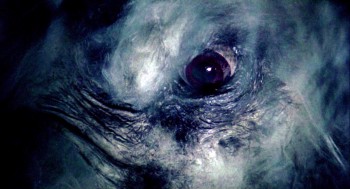 But if Richard Sale wasn’t jonesing to Jaws, there can be no doubt that the reason producer Dino de Laurentiis picked Sale’s novel for movie adaptation was because of its similarities with what was then the highest-grossing film in history. De Laurentiis dipped into the Jaws well a second time during the summer of 1977 with the infamous Orca, a movie that’s actually better than you’ve heard it is thanks to the presence of Richard Harris.
But if Richard Sale wasn’t jonesing to Jaws, there can be no doubt that the reason producer Dino de Laurentiis picked Sale’s novel for movie adaptation was because of its similarities with what was then the highest-grossing film in history. De Laurentiis dipped into the Jaws well a second time during the summer of 1977 with the infamous Orca, a movie that’s actually better than you’ve heard it is thanks to the presence of Richard Harris.
Its cinematic influences aside, The White Buffalo does manage to forge its own identity. Part of it is the presence of Charles Bronson, a genre unto himself. The rest comes from the weird tone and style, which makes it difficult to think that the film could have managed to strike a chord with any general audience when it was released. It’s unfortunate that pure mood and pure Bronson don’t add up to a film as good as its premise.
Bronson plays Wild Bill Hickok on the downslope of his career, his eyesight failing behind tinted glasses. It’s 1874, and Hickok is coming back from a failed stage career in New York with Buffalo Bill. Traveling under the name “Mr. James Otis” to avoid vengeance seekers (it doesn’t work — he gets in a shootout at the first town he stops in), Hickok is pursuing a nightmare vision of a white buffalo that torments him to the edge of madness. The film never offers an explanation for these visions; they only prod Hickok out into the wilderness to face his destiny or some other hero-building 12-step program. But I like Charles Bronson as a screen persona, so I can excuse this. Bronson looks nothing like the actual Wild Bill Hickok, who was thought something of a dandy because of his soft face and sartorial concerns over his looks. But Bronson is ideal for this Wild Bill, a beaten and sagging man coming near the end of his violent life. With the round tinted glasses and long hair, Bronson has something of a counterculture swing to his Wild Bill. Toss that onto the “1970s fun” pile.
Will Sampson, who also popped up in Orca a few months later, plays the other obsessed hunter of the white beast, Crazy Horse. The famous Oglala Lakota war leader must avenge the death of his daughter at the buffalo’s horns. Like Hickok, he travels under a different name, “Worm,” although this is not his choosing. Crazy Horse lost his true name because of his open weeping for his daughter’s death, and the quest to regain his true name requires the death of the buffalo. Sampson, who is best known for his roles in One Flew over the Cuckoos Nest and The Outlaw Josey Wales, gives an adequate performance that relies more on his magnificent features and bearing than his skill at delivering dialogue. Sampson and Bronson feel stilted in most of their scenes together, and Bronson doesn’t sound believable speaking the faux-Zen wisdom lines that make up most of his dialogue in these encounters. The first two meetings between Crazy Horse and Hickok are unintentionally hilarious because they sign to each other while needlessly shouting out perfect English. However, in their final moments together, both men at last find common acting ground for an effective, downbeat curtain closer.
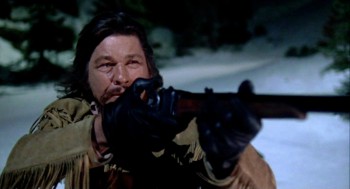 Bronson works better across from Jack Warden as “One Eye” Charlie Zane, the third side of the triangle of hunters who are the only characters in the final third of the movie. Warden gets second billing, and even though the actor was born only one year before Bronson, he’s able to sell himself as an “old timer” on screen. Warden gives the most accomplished pure performance in the movie, although it doesn’t have the thrill of Bronson’s simple presence.
Bronson works better across from Jack Warden as “One Eye” Charlie Zane, the third side of the triangle of hunters who are the only characters in the final third of the movie. Warden gets second billing, and even though the actor was born only one year before Bronson, he’s able to sell himself as an “old timer” on screen. Warden gives the most accomplished pure performance in the movie, although it doesn’t have the thrill of Bronson’s simple presence.
Some established Western stars make their way through the story in small and supporting parts. Clint Walker has the meatiest role, cast against type as a villain who bolsters up the middle act when he goes after Hickok for killing his son in a forgettable bar shootout. John Carradine, with his delivery as quirky as any of his mad scientist roles, makes a memorable one-scene undertaker in what would otherwise be a bland bit of exposition. Stuart Whitman plays a foul-mouthed stagecoach passenger who mistakes Hickok for a greenhorn and then pays the price. The stagecoach driver is Slim Pickens playing Slim Pickens. Blink and you’ll miss Karate Kid’s Martin Kove serving drinks in the Frozen Dog Saloon.
The only important female character is Poker Jenny, a role that seems like it should have been played by Charles Bronson’s wife, Jill Ireland. The two-scene part is not far removed from the character Jill Ireland played in The Mechanic (1972), the brief romantic encounter to sand off one of the many rough edges of a Bronson character. Novak appears long enough to show a softer side to Wild Bill and a peek into his past, but Bronson lacks the chemistry with Novak that he had with Ireland in similar parts. Novak works while she’s on screen, but by the time the credits roll you won’t even remember she was there.
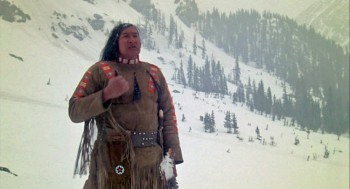 English-born director J. Lee Thompson has a long filmography, which includes one of the best of the “Planet of the Apes” films, Conquest of the Planet of the Apes (1972), and a bulky number of Bronson films. On The White Buffalo, Thompson seems to have put most of his effort into the “monster” scenes, and left the standard Western beats to fend for themselves. The obstacles Hickok faces leading up to the confrontation with the buffalo are haphazard occurrences brought out of a Western 101 playbook, with two separate saloon shootouts, neither of them handled with much flair. Thompson doesn’t stick the landing at the finale either. The build to the showdown with the white buffalo is intense, but the important triumphant moment seems never to have gotten in front of the cameras. The fight between the three hunters and the giant buffalo just sort of… stops. The drama that happens afterwards between Hickok and Charlie Zane over what they should do about Crazy Horse is more pointed than the buffalo battle itself.
English-born director J. Lee Thompson has a long filmography, which includes one of the best of the “Planet of the Apes” films, Conquest of the Planet of the Apes (1972), and a bulky number of Bronson films. On The White Buffalo, Thompson seems to have put most of his effort into the “monster” scenes, and left the standard Western beats to fend for themselves. The obstacles Hickok faces leading up to the confrontation with the buffalo are haphazard occurrences brought out of a Western 101 playbook, with two separate saloon shootouts, neither of them handled with much flair. Thompson doesn’t stick the landing at the finale either. The build to the showdown with the white buffalo is intense, but the important triumphant moment seems never to have gotten in front of the cameras. The fight between the three hunters and the giant buffalo just sort of… stops. The drama that happens afterwards between Hickok and Charlie Zane over what they should do about Crazy Horse is more pointed than the buffalo battle itself.
The White Buffalo misses some other opportunities, such as exploring Hickok’s dreams or exploiting his fading eyesight for real tension. The movie starts with narration from a train conductor, then completely abandons the idea.
The tagline on the posters, “You won’t believe your eyes!” is accurate, but not in the way the publicity department intended. Enjoyment of The White Buffalo depends on how much viewers can get into the stage-bound style the budget forced on Thompson. The buffalo is predominantly photographed in close shots combined with quick cuts to disguise that it’s not highly mobile. The animal’s hindquarters never appear because the prop is mounted on a truck. When the buffalo rampages through a Sioux camp early in the movie, the claustrophobic soundstage (complete with fog-machine mist clinging to the ground) and jumpy editing turn the scene into a mess that calls attention to the budget. Fortunately, the buffalo fares better in other scenes and in the final showdown the editing and the creature’s leaping movements have developed into what might be called “style.” The close-ups on its staring eye and steaming nostrils, and the slow camera movements over its albino coat during Wild Bill’s nightmares are the best use of the title monster.
Half the film’s atmosphere comes from the musical score by the legendary John Barry. It’s an unusual score for the composer, dwelling in a dark, low register netherworld far removed from his James Bond sound or the lyrical romanticism of Somewhere in Time, Out of Africa, and his major Western score, Dances with Wolves. While a handful of Barry’s scores to lesser-known films from this period like Raise the Titanic and The Black Hole (easily one of the top five scores in his catalog) have attained fame among fans, the music for The White Buffalo is a drag to listen to on its own. The low dronings punctuated by ethnic percussion offer little dynamism, and this makes up three-quarters of the score. But the music is ideal accompaniment for the film, bringing the horror aura to the action without hitting generic Western notes or copying the action music style of the era. The theme for the buffalo rumbles and threatens enough to cover many of the deficiencies of the actual creature.
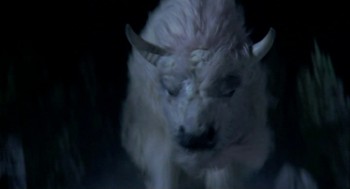 The White Buffalo was released on 6 May 1977 in the U.S., and died fast at the box office despite Bronson’s robust post-Death Wish celebrity. The Western was struggling in the late ‘70s and viewers were already getting leery of movies looking to snatch some of that Jaws cash. Also not helping: the release two weeks later of Star Wars, which guaranteed the kids who might have kept The White Buffalo chugging along in theaters a bit longer had a much larger destroying monster on their minds — the Death Star. The White Buffalo has only maintained enough cult status from genre fans to get it that DVD-R release thirty years later.
The White Buffalo was released on 6 May 1977 in the U.S., and died fast at the box office despite Bronson’s robust post-Death Wish celebrity. The Western was struggling in the late ‘70s and viewers were already getting leery of movies looking to snatch some of that Jaws cash. Also not helping: the release two weeks later of Star Wars, which guaranteed the kids who might have kept The White Buffalo chugging along in theaters a bit longer had a much larger destroying monster on their minds — the Death Star. The White Buffalo has only maintained enough cult status from genre fans to get it that DVD-R release thirty years later.
In this time of unnecessary re-makes, The White Buffalo is a film that could justify getting a second turn in front of cameras. With the special effects available today, the albino buffalo could be a fantastic creation — provided the CGI people still keep it shadowy and weird and the director avoids the temptation to throw it on screen as often as possible. Almost everything about the movie could be improved today, except Bronson’s performance. Maybe stick Viggo Mortensen in the lead. I wonder if David Cronenberg would be interested in directing a horror-Western?
Presentation notes: The MGM Limited Edition Collection DVD advertises on the back cover that The White Buffalo is “full frame,” the code words for “Pan & Scan” 1.33:1. But have no fear, the movie’s original 1.85:1 aspect ratio is preserved and enhanced for widescreen televisions. There are no extras of any kind, not even a menu, and chapter stops are dispersed at five-minute increments. There’s plenty of moaning on Amazon customer reviews (yeah, that’s a shock) about the DVD-R not playing, but I tried my copy on two different “play-only” DVD players and my iMac and it worked on all three without a glitch.
Ryan Harvey is a veteran blogger for Black Gate and an award-winning science-fiction and fantasy author who knows Godzilla personally. He received the Writers of the Future Award for his short story “An Acolyte of Black Spires,” and his story “The Sorrowless Thief” appears in Black Gate online fiction. Both take place in his science fantasy world of Ahn-Tarqa. A further Ahn-Tarqa adventure, “Farewell to Tyrn”, the prologue to the upcoming novel Turn Over the Moon, is currently available as an e-book. You can keep up with him at his website, www.RyanHarveyWriter.com, and follow him on Twitter.
I was like 8 or 9 when I saw this flick on HBO (one of only a dozen cable channels available at the time in my hometown). I remember it being exciting enough and interesting enough to capture my pre-teen mind and attention. I’m looking forward to giving this a re-look.
I agree this one could stand remaking. It’s a fascinating story and the film really suffers from the cheap special effects. Richard Sale’s novel does not suffer from such limitations, and I find it far superior to the film. Surprised you didn’t like it. Sale, incidentally, was co-creator of one of my favorite TV series of yesteryear: Yancy Derringer starring Jock Mahoney and X Brands as the mute Pawnee Pahoo-Ka-Ta-Wa, Wolf Who Walks on Water.
It’s hard to think of a film more notable for what it isn’t than for what it is. Dross from start to finish, but so eccentric and unlikely that it remains impossible to dismiss.